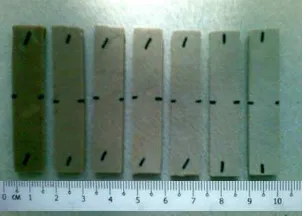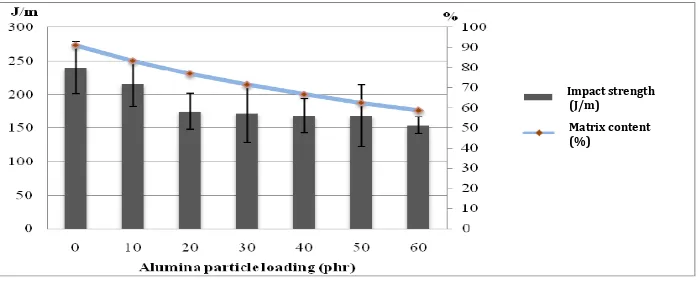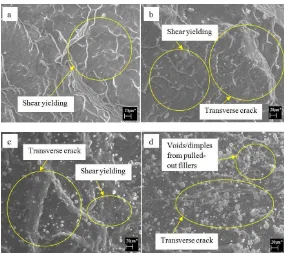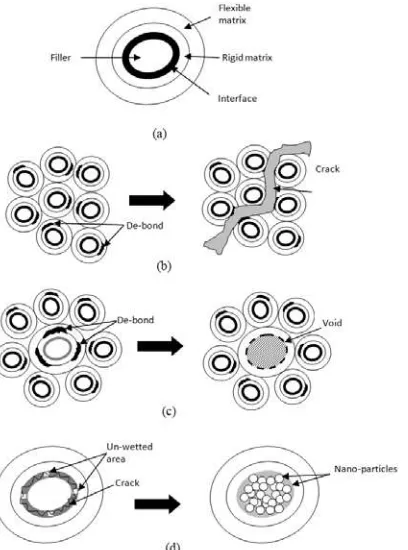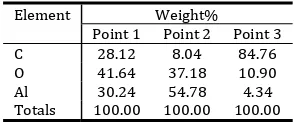NORA)(AM MO(AMAD , ANDANASTUT) MUC(ATAR2
Much research has been carried out in the development of nano-filled composites through the incorporation of nano-scale materials such as ceramics and carbon in polymer matrix. For instance organoclays Teh et al., ,
carbon nanotubes Shanmugharaj et al., , alumina nanoparticles Siegel et al., and silica
nanoparticles Park et al., have been added to polymers. Polymer nanocomposites exhibit unique
properties even by the addition of a low weight percent nanofillers < wt. % , that cannot be obtained from conventional or micro-scale fillers López-Manchado et al., . The incorporation of nanofillers enhances
mechanical, electrical, optical and other properties of polymer composites without sacrificing too much of the needed properties such as toughness being traded for stiffness as that found in rubber filled carbon fibres et al., , polyethylene terephthalate PET Bhimaraj et al., , polymetylmetacrylate PMMA Costache et al., , polycarbonate Chandra et al., & Eitan et al., etc. , and polymer blends Kontopoulou et al., & Arroyo et al., .
The development of polymer-ceramic nanocomposites has created a number of technologies and
ABSTRACT
This paper examined the effect of alumina nanoparticles to the impact strength of ENR and emphasis on morphological characteristics of the materials. Epoxidized natural rubber-alumina
nanoparticle composites(ENRAN) was successfully prepared through direct melt compounding
process using an internal mixer. It was cured by sulphur semi efficient curing system using a hot press. Loading of alumina nanoparticles in the epoxidized natural rubber (ENR) matrix were varied from 10, 20, 30, 40, 50 to 60 phr. Izod impact test was performed on samples and fracture surfaces were directly examined under Scanning Electron Microscope (SEM). The impact strength decreased with increased filler loading. The composites were observed to fail in moderately brittle fracture due to frozen state by liquid nitrogen and embrittlement effect of hard alumina as the ratio of filler to matrix increased. Energy absorption by filler pull-out suppressed the mechanism of matrix yielding and matrix cracking. The decrease in matrix to filler ratio and the increase in agglomeration and crosslink density had contributed to the diminishing impact strength of the composites.
Keywords: Rubber, Alumina, Impact Fracture, Energy Absorption Mechanism, Morphology.
INVESTIGATION ON IMPACT FRACTURE OF EPOXIDIZED
NATURAL RUBBER-ALUMINA NANOPARTICLE COMPOSITES
polar polymers when compared to non-polar polymers such as NR Teh et al., . ENR is miscible with more
polar polymers )smail et al., therefore offering unique properties such as good oil resistance, low gas
permeability, a higher wet grip, rolling resistance, and a higher tensile strength. The oil resistance of ENR vulcanizate is reported to almost meet the characteristics of medium-acrylonitrile-content nitrile rubber and also surpasses that of CR )smail et al., . The resistance to air permeability of ENR is also claimed to be
comparable to butyl rubber and medium-acrylonitrile-content nitrile rubber )smail et al., . Alumina has
been recognized as a structural material with an extremely high melting point °C , a high degree of
hardness, and is capable in taking on diverse shapes and functions Noboru, .
The potential of polymer filled alumina nanoparticle composites in wear and tribology, optical and electrical have been studied by some researchers Bhimaraj et al., , Chandra et al., & Gatos et al.,
. The incorporation of nano-scaled alumina in PP has improved the mechanical properties of the polymer composites Jung et al., and increased the wear resistance of PET filled alumina nanoparticles by nearly
two times over the unfilled polymer Bhimaraj et al., . There have also been several reports of improved
ductility and toughness in brittle thermoset polymers due to the addition of alumina nanoparticles Ash et al.,
& Ash et al., . )n our previous study Mohamad et al., , the addition of alumina nanoparticles
in ENR has proven to accelerate the curing process to m% and has also increased the tensile modulus at % and % elongation up to % compared to unfilled ENR.
The ability of nanofillers to improve the tensile properties especially in modulus and strength when added at relatively low levels ~ wt. % to thermosets and thermoplastics has been well documented and reviewed Ajayan et al., , Arroyo et al., & Chen and Evans, . (owever, the effect of fillers on
toughness, particularly toughness as measured by pendulum impact tester is rather uncertain. Chen & Evans has listed down several studies which have shown reduction in unnotched impact strength of nanocomposites with increasing filler content. Moreover, they addressed the issue of why most researchers were trying to avoid the use of impact tests in determining the toughness of their nanocomposites except by referring the value of tensile elongation at break of the materials Mohd Yuhazri et al., . Besides avoiding
impact tests due to their ambiguities such as unstable crack growth, wide range of energy sinks and ill-defined notch radius Chen and Evans, , researchers pay less attention to use the impact tester due to the physical characteristic of the materials to be tested.
The nature of rubber based nanocomposites at room temperature which are soft and flexible, make utilization of conventional pendulum impact tester to determine toughness appear somewhat impossible. This is evidence by less documented studies on this particular area. (owever, in this work we studied the impact strength and morphology focusing on the effect of fillers content to the hardened rubber composites; epoxidized natural rubber-alumina nanocomposites. )n this study brittle fracture is induced on the samples, so then, the ability of the materials to absorb energy under severe condition is observed. The mechanism involved in energy absorption of the impact failures will reveal the factors contributing to the failure as well as being a good indicator of matrix-filler interaction of the materials.
2.0 METHODOLOGY
2.1 Materials
Table shows the formulation used in this study. )n these recipes, the content of alumina nanoparticles was varied from , , , , to phr whereas the rubber and other ingredients were kept constant. Epoxidized natural rubber was supplied by the Malaysian Rubber Board under the trade name ENR with % epoxidization. The Mooney viscosities measured at ML + °C was . . Alumina
nanoparticles were obtained from Nanostructured & Amorphous Materials )nc., USA with size ranging from to nm. Sulphur, zinc oxide, and stearic acid were purchased from Systerm/Classic Chemicals Sdn Bhd, Tetramethylthiuram disulfide TMTD from Aldrich Chemistry and other chemicals such as N-cyclohexylbenthiazyl sulphenamide CBS and N- , -Dimethylbutyl -N'-phenyl-p-phenylenediamine
PPD were supplied by Flexsys America, USA.
2.2 Mixing & Cure Characteristics
The compounding process was performed according to ASTM D- and carried out using an internal mixer (aake working at °C and a rotor speed of rpm for min Mohamad et al., . Firstly, ENR
was masticated for min before all ingredients except sulphur were added and mixed for another min. Finally, sulphur was added and mixed for about min before the mixture was dumped and cooled down to room temperature. From this stock, unvulcanised samples were cured using a semi efficient vulcanisation EV system in a hot press at °C at the respective cure times, t which was derived from
Table 1: Coding of samples and their formulation
INGREDIENTS LOADINGS (phr)a
ENR ENRAN ENRAN ENRAN ENRAN ENRAN ENRAN ENR
Sulphur . . . .
Zinc oxide . . . .
Stearic acid . . . .
CBSb . . . .
TMTDc . . . .
PPDd . . . .
Alumina
NOTE: a Parts per hundred rubber, b N-cyclohexylbenthiazyl sulphenamide, c Tetramethylthiuram disulfide d N- , -Dimethylbutyl -N'-phenyl-p-phenylenediamine
2.3 Impact Testing
Samples prepared according to ASTM D as shown in Figure were tested for impact strength for un-notched )zod pendulum impact resistance using a CEAST impact tester. They were dipped into liquid nitrogen for min before the samples were clamped to the machine and stroked by a pendulum at an energy level of J. All tests were conducted at room temperature °C . The temperature of each samples ware approximately - °C due to the thermal equilibrium with liquid nitrogen.
Figure 1: Sample for un-notched )zod impact test.
2.4 Scanning Electron Microscope (SEM)
The examination of the impact fracture surfaces were carried out using a scanning electron microscope ZE)SS EVO at magnifications of x and x. For every sample, a minimum of three micrographs at each magnification were taken to ensure a high confidence level in the analysis. The fractograph was observed and the morphologhy was analysed qualitatively. The micrographs were captured under variable pressure.
2.5 Field Emission Scanning Electron Microscope (FESEM)
The ENRAN for and phr were examined under FESEM ZE)SS SUPRA VP . Samples were cut using a scissor and the fracture surfaces were gold coated using a gold sputter. The step is to reduce charging effect of non-metallic samples. The samples were observed under secondary electron at kV Zakaria, . Point analysis was conducted on the samples using an energy-dispersive X-ray spectrometer EDX to identify different phases of ENRAN.
3.0 RESULTS AND DISCUSSION
3.1 Impact Strength
al., . (owever, according to Chen and Evans , the absorption of energy in a tensile test cannot
be correlates with the level of toughness at impact strain rate.
The main factor causing the reduction in impact strength of ENRAN at macro scale was the effect of the ratio between the ENR matrix content and alumina filler. As the content of alumina particles in the ENRAN compound increases, the percentage of matrix in the composite decreases Figure . While taking into account the rule of mixture in which the composite properties are the volume weighed average of the phases matrix and dispersed phase properties; the impact strength decreases Ashrafi et al., &
McGrath et al., . This was because the energy absorption capability was dominated by the matrix
while, ceramic fillers contributed more to the stiffness and hardness of the composite material. Thus, the content of matrix in a composite is a very important factor to determine the impact strength. This argument supported by Chen and Evans who concluded that the impact strength of nylon in their study was less sensitive to the effect of filler dispersion and either the filler produced conventional particle’s filled composites, or nanocomposites. According to them Chen and Evans, , the decline and instability in impact strength continued to be observed despite the nylon-montmorillonite nanocomposites showed excellent tensile properties. Besides, the increment observed in tensile strength may be due to high proportion of polysulphidic crosslinks presence in the rubber composite. The S-S bond in crosslinks has the ability to break reversibly, thereby relieving locally high stresses that could initiate failure Gent, . (owever, vulcanizates containing polysulphidic crosslinks has lower heat stability, set resistance and reversion resistance than those with monosulphidic crosslinks.
Figure 2: )mpact strength and percentage of matrix at various filler loading in ENRAN
)n this study, the decrease in impact strength with increasing alumina particles loading was also due to the increase in degree of crosslinking Mohamad et al., & Mohamad et al., . Although
test on specimen without notch gives greater emphasis to the ductility after cracking starts and can be used to detect the presence of agglomerate. Despite the decreased in impact strength can be associated with increasing agglomerates density, but the effect was compensated by nearly spherical agglomerates. )t was evident from the very small reduction in impact strength less than % displayed by the ENRAN eventhough the ENR matrix was reinforced with phr alumina. For comparison, a greater reduction % was observed in ABS-clay nanocomposites when compared with unfilled ABS even the micrographs showed the presence of nano structures in the materials Chen and Evans, .
Besides, the reduction observed in impact strength may also be due to the difference in samples temperature with their glass transition temperature, Tg. The impact samples were hardened by liquid nitrogen at temperature of approximately - °C whereas Tg of ENRAN samples were increased as the filler
loading increased Mohamad et al., & Mohamad et al., . A narrower temperature difference,
∆T decreased the impact strength of the composites since it causes the matrix chains becoming more rigid and reduces its ability to deform during stress Zhang and Zhang, . Furthermore, the reduction in ∆T increases the shear rate and makes the materials prone to brittle fracture.
Impact strength (J/m)
3.2 Microscopy Analysis on Impact Fracture Surface
The impact fracture surfaces of ENRAN at x magnification are shown in Figure . Control sample for morphological and microstructural analysis is the micrograph of ENR fracture surface Figure a . Dark phases represent the ENR matrix and the bright phases are alumina particles. ENR micrograph shows ductile fracture failure apparently by shear yielding. )t is depicted by close narrow ridges formed on the fracture surface parallel to the applied force. Since there were no hard particles, the matrix easily deformed and dissipated high impact energy from shear yielding.
Whereas, ENRAN impact fracture is a mixture of shear yielding, matrix cracking, matrix de-bonding, pull-out filler and split filler. )t can be seen that at low filler loading Figure b the failure mechanism was still dominated by shear yielding but with a very low level of pulled-out and split fillers. The degree of shear yielding decreased as the filler loading increased. This is due to the molecular movement of rubber chains was restricted by alumina particles. (owever, fracture surface of ENRAN seemed to have higher surface roughness than ENR . This is evident from fibrillar structure on the fracture surface when the sample was examined at high magnification of x Figure . But, the micrograph of ENR shows a relatively smoother surface than ENRAN even at the same magnification. The fibrillar structure is an indication of ductile failure which absorbed higher impact energy than ENR . Even so, the behaviour of this fracture is not consistent with the value of recorded impact strength. This is due to the presence of agglomerates and ∆T as discussed earlier.
Figure 3: SEM fractographs of (a) unfilled ENR vulcanizate, ENR and ENRAN at (b) phr (c) phr and (d) phr of alumina
nanoparticles loading at x magnification.
Figure 4: Comparison of failure criterion at high magnification of x for a ENR and b ENRAN
As de-bonds at molecular difference between matrix and fillers coalesce and grow unstably, a transverse crack formed. This is evident in micrograph Figure and b where the transverse crackings mostly happened in matrix and close to the matrix-filler interfaces. But, for fillers which were not fully or uniformly wetted by matrix, the concentrated stresses at the molecular difference between matrix and fillers tend to form microcracks at their interfaces Figure d . These microcracks were then propagated through the fillers and cut the fillers into two parts and produced split fillers Figure b . This mechanism occurred in a condition when the adhesion force between matrix and fillers that stay in infinite contact were higher than the secondary bonds that hold the particles together in their clusters. Furthermore, this mechanism was observed to happen in particles with diameter surpassed their critical size ~ µm as shown in Figure b.
Figure 5:(a) Schematic of matrix-filler interaction (b) Formation of transverse crack from matrix de-bonding (c) Filler pull-out due
to matrix de-bonding and (d) Split filler due to circumferential crack propagation across filler
Even though the increasing of filler loading in ENR matrix showed a decreasing pattern in their impact strength, however, the matrix exhibited good wettability on alumina fillers. This is in good agreement with microstructural and morphological analysis performed on the samples. Most of the failures occurred in matrix instead of fillers or at the interfaces. )n addition, the matrix phase seems stretched to a large strain before failure even at high density agglomerate. )t comes from good filler-matrix interaction, increasing number of crosslinks, nearly spherical form and uniform distribution of. The wettability is evident form low colour contrast between fillers and matrix in high resolution FESEM micrograph as shown in Figure a. This criterion is an indicator of wetted fillers by matrix Mohamad et al., . This was confirmed from EDX analysis performed at various point point , , and on ENRAN
impact fracture due to pulled-out filler. Point is a point on the cross-sectional of split filler with a higher Al and O content compared to C element. The presence of carbon in point analysis at C is an indication of bound rubber which presence in between of particles in the agglomerates Gent, . Whereas, point is the point where majority hosted by matrix shown by the highest C level with traces of aluminium Al and oxide O element due to nano-scale dispersed fillers.
Figure 6: FESEM micrograph of a ENRAN and b ENRAN at magnifications of x
Table 2: EDX analysis at three different points on ENRAN fracture surface; point was on fillers agglomerates, point was on
split filler , and point was on majority matrix phase
4.0 CONCLUSION
)mpact properties of hardened rubber based vulcanizates were studied using a pendulum impact tester. )t was observed that unfilled ENR vulcanizate failed in ductile fashion mainly through shear yielding compared to ENRAN. The toughness of ENRAN decreases as the filler loading increases which was reflected by diminished of their impact strength. The increasing of alumina loadings increased the probability of brittle failure in ENRAN. This was due to matrix to filler ratio, presence of agglomerates and ∆T values. The morphologies showed the presence of transverse cracks, dimples and fractured fillers due to matrix cracking, matrix de-bonding, filler pull-out and split fillers mechanism.
ACKNOWLEDGMENTS
The authors acknowledge the Ministry of (igher Education Malaysia and Universiti Kebangsaan Malaysia UKM for granting the Fundamental Research Grant Scheme UKM-RS- -FRGS - to carry out this project. We wish to sincerely thank the Malaysia Nuclear Agency for providing the equipment and technical assistance to carry out the experiments. The first author is grateful to Universiti Teknikal Malaysia Melaka UTeM for granting concession and study
REFERENCES
[ ] Teh, P.L., Mohd )shak, Z.A., (ashim, A,S., Karger-Kocsis, J., )shiaku, U.S. : Effects of Epoxidized Natural Rubber as a Compatibilizer in Melt Compounded Natural Rubber–organoclay Nanocomposites. Euro Poly J.
, pp. - .
[ ] Shanmugharaj, A.M., Bae, J.(., Lee, K.Y., Noh, W.(., Lee, S.(. and Ryu, S.(. : Physical and Chemical Characteristics of Multiwalled Carbon Nanotubes Functionalized With Aminosilane and its )nfluence on the Properties of Natural Rubber Composites. Compo Sci & Tech., , pp. – .
[ ] Siegel, R.W., Chang, S.K., Ash, B.J., Stone, J., Ajayan, P.M. and Doremus, R.W. : Mechanical Behavior of Polymer and Ceramic Matrix Nanocomposites. Scripta mater., , pp. – .
[ ] Park, S.J., Jin, S.Y. and Kaang, S. : )nfluence of Thermal Treatment of Nano-scaled Silica on )nterfacial Adhesion Properties of the Silica/Rubber Compounding. Mater Sci & Eng A., , pp. – .
[ ] López-Manchado, M.A., Valentín, J.L., Carretero, J., Barroso, F. and Arroyo, M. : Rubber Network in Elastomer Nanocomposites. Euro Poly J., : pp. - .
[ ] Ajayan, P.M., Schadler, L.S. and Braun, P.V. : Nanocomposite Science and Technology. Weinheim: Wiley-Vch Verlag Gmb( & Co. KGaA .
[ ] Peng, Z., Kong, L.X., Li, S.D., Chen, Y. and (uang, M.F. : Self-assembled Natural Rubber/Silica
Element Weight%
Point Point Point
C . . .
O . . .
Al . . .
[ ] Vu, Y.T., Mark, J.E., Pham, L.Y.(. and Engelhardt, M. : Clay Nanolayer Reinforcement of cis , -Polyisoprene and Epoxidized Natural Rubber. J Ap Poly Sci., , pp. – .
[ ] Varghese, S., Karger-Kocsis, J. and Gatos, K.G. : Melt Compounded Epoxidized Natural Rubber/Layered Silicate Nanocomposites: Structure-Properties Relationships. Poly., , pp. – .
[ ] Ahankari, S.S. and Kar, K.K. : Processing of Styrene Butadiene Rubber-carbon Black Nanocomposites With Gradation of Crosslink Density: Static and Dynamic Mechanical Characterization. Mat Sci & Eng A.,
- : pp. - .
[ ] Falco, A.D., Goyanes, S., Rubiolo, G.(., Mondragon, ). and Marzocca, A. : Carbon Nanotubes as Reinforcement of Styrene Butadiene Rubber. Appl Surf Sci., , pp. - .
[ ] Das, A., Costa, F.R., Wagenknecht, U. and (einrich, G. : Nanocomposites Based on Chloroprene Rubber: Effect of Chemical Nature and Organic Modification of Nanoclay on the Vulcanizate Properties.
Euro Poly J., , pp. – .
[ ] Chang, Z.(., Guo, F., Chen, J.F., Yu, J.(. and Wang, G.Q. : Synergistic Flame Retardant Effects of Nano-Kaolin and Nano-(AO on LDPE/EPDM Composites. Poly Degrad & Stabil., , pp. - .
[ ] Jose, M.V., Steinert, B.W., Thomas, V., Dean, D.R., Abdalla, M.A. and Price G. : Morphology and Mechanical Properties of Nylon /MWNT Nanofibers. Poly., , pp. - .
[ ] Kalaitzidou, K., Fukushima, (. and Drzal, L.T. : A New Compounding Method for Exfoliated Graphite– Polypropylene Nanocomposites with Enhanced Flexural Properties and Lower Percolation Threshold.
Comp Sci & Tech., : pp. - .
[ ] (asan, M.M., Zhou, Y. and Jeelani, S. : Thermal and Tensile Properties of Aligned Carbon Nanofiber Reinforced Polypropylene. Mat Let., , pp. – .
[ ] Bhimaraj, P., Burris, D.L., Action, J., Sawyer, W.G., Toney, C.G. and Siegel R.W. : Effect of Matrix Morphology on the Wear and Friction Behavior of Alumina Nanoparticle/Poly ethylene Terephthalate Composites. Wear., , pp. – .
[ ] Costache, M.C., Wang, D., (eidecker, M.J., Manias, E. and Wilkie, C.A. : The Thermal Degradation of Poly methyl methacrylate Nanocomposites with Montmorillonite, Layered Double (ydroxides and Carbon Nanotubes. Poly Adv Tech., , pp. – .
[ ] Chandra, A., Turng, L.S., Gopalan, P., Rowell, R.M. and Gong, S. : Study of Utilizing Thin Polymer Surface Coating on the Nanoparticles for Melt Compounding of Polycarbonate/Alumina Nanocomposites and Their Optical Properties. Comp Sci & Tech., , pp. – .
[ ] Eitan, A., Fisher, F.T., Andrews, R., Brinson, L.C. and Schadler, L.S. : Reinforcement Mechanisms in MWCNT-Filled Polycarbonate. Comp Sci &Tech., , pp. – .
[ ] Kontopoulou, M., Liu, Y., Austin, J.R., and Parent J.S. : The Dynamics of Montmorillonite Clay Dispersion and Morphology Development in )mmiscible Ethyleneepropylene Rubber/Polypropylene Blends. Poly., , pp. - .
[ ] Arroyo, M., Lo´pez-Manchado, M.A., Valentı´n, J.L. and Carretero J. :Morphology/Behaviour Relationship of Nanocomposites Based on Natural Rubber/Epoxidized Natural Rubber Blends. Compo Sci & Tech., - : pp. - .
[ ] )smail, (. and Chia, (.(. :The Effects of Multifunctional Additive and Vulcanization Systems on Silica Filled Epoxidized Natural Rubber Compounds. Euro Poly J., , : pp. - .
[ ] Noboru, ). : )ntroduction to Fine Ceramics Application in Engineering . New York: John Wiley & Sons Ltd.; .
[ ] Gatos, K.G., Martı´nez Alca´zar, J.G., Psarras, G.C., Thomann, R. and Karger-Kocsis, J. : Polyurethane Latex/Water Dispersible Boehmite Alumina Nanocomposites: Thermal, Mechanical and Dielectrical Properties. Comp Sci and Tech., , pp. – .
[ ] Jung, C.(., Choi, J.(., Lim, Y.M., Jeun, J.P., Kang, P.(. and Nho, Y.C. :Preparation and Characterization of Polypropylene Nanocomposites Containing Polystyrene-Grafted Alumina Nanoparticles. J. Ind. Eng. Chem.
, : pp. - .
[ ] Ash, B.J., Schadler, L.S. and Siegel, R.W. : Glass Transition Behaviour of Alumina Polymethylmethacrylate Nanocomposites. Mat. Let., , pp. - .
[ ] Ash, B.J., Siegel, R.W. and Schadler, L.S. : Mechanical Behavior of Alumina/ Poly methyl Methacrylate Nanocomposites. Macromolecules., , pp. – .
[ ] Mohamad, N., Muchtar, A., Ghazali, M.J., Dahlan, (.M. and Azhari, C.(. : The Effect of Filler on Epoxidized Natural Rubber-Alumina Nanoparticles Composites. Euro J of Sci Res., : pp. - .
[ ] Chen, B. and Evans J.R.G. :)mpact and Tensile Energies of Fracture in Polymer–Clay Nanocomposites.
Polymer., , pp. – .
[ ] Annual Book of ASTM Standards. Vol . . West Conshohocken, PA United States: American Society for Testing of Materials; .
[ ] Mohamad, N., Muchtar, A., Ghazali, M.J., Dahlan, (.M. and Azhari C.(. :Epoxidized Natural Rubber-Alumina Nanoparticle Composites: Optimisation of Mixer Parameters via Response Surface Methodology
[ ] Annual Book of ASTM Standards. West Conshohocken, PA United States: American Society for Testing of Materials; .
[ ] Zakaria, F.A. : The Effect of Pore Size and Pore Geometry on the Strength of Porous (ydroxyapatite.
Solid State Science and Technology, - : pp. - .
[ ] Ashrafi, B., (ubert, P. and Vengallatore, S. : Carbon Nanotube-Reinforced Composites as Structural Materials for Microactuators in Microelectromechanical Systems. Nanotechnology., , pp. – .
[ ] McGrath, L.M., Parnas, R.S., King, S.(., Schroeder, J.L, Fischer, D.A. and Lenhart, J.L. : )nvestigation of the Thermal, Mechanical, and Fracture Properties of Alumina Epoxy Composites. Polymer., , pp. - .
[ ] Mohd Yuhazri, Y., Phongsakorn, P.T., (earyip Sihombing, Jeefferie, A.R., Puvanasvaran Perumal, Kamarul, A.M. and Kannan Rassiah. : Mechanical Properties of Kenaf/Polyester Composites. International Journal of Engineering & Technology. Vol. . No. . pp. - .
[ ] Gent, A.N. Engineering with Rubber-(ow to Design Rubber Components. nd Ed. Carl (anser Verlag. Munich. .
[ ] Mohamad, N., Muchtar, A., Ghazali, M.J., Dahlan, (.M. and Azhari, C.(. : Correlation of Filler Loading and Silane Coupling Agent on the Physical Characteristics of Epoxidized Natural Rubber-Alumina Nanoparticles Composites.J of Elas & Plas., , pp. - .
[ ] Zhang, (. and Zhang, Z. : )mpact Behaviour of Polypropylene Filled With Multi-Walled Carbon Nanotubes. European Polymer Journal., , pp. – .
